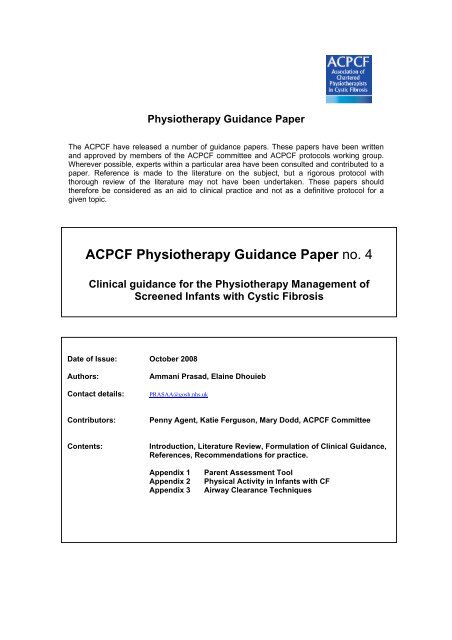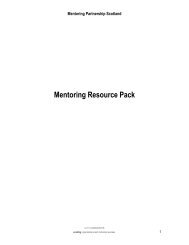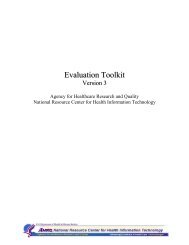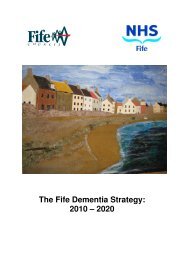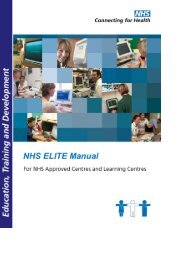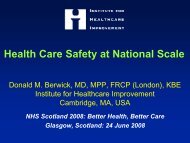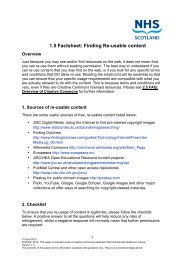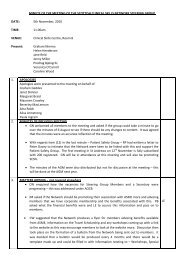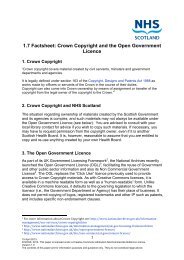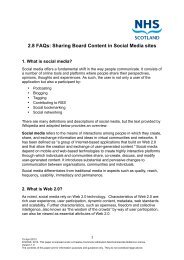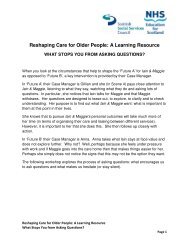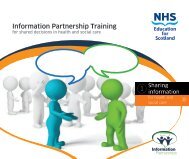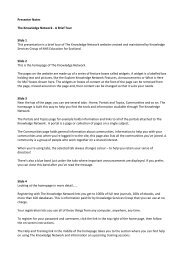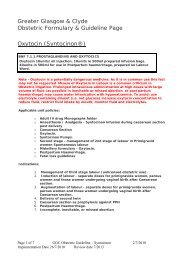ACPCF Infant Guideline - The Knowledge Network
ACPCF Infant Guideline - The Knowledge Network
ACPCF Infant Guideline - The Knowledge Network
Create successful ePaper yourself
Turn your PDF publications into a flip-book with our unique Google optimized e-Paper software.
Physiotherapy Guidance Paper<br />
<strong>The</strong> <strong>ACPCF</strong> have released a number of guidance papers. <strong>The</strong>se papers have been written<br />
and approved by members of the <strong>ACPCF</strong> committee and <strong>ACPCF</strong> protocols working group.<br />
Wherever possible, experts within a particular area have been consulted and contributed to a<br />
paper. Reference is made to the literature on the subject, but a rigorous protocol with<br />
thorough review of the literature may not have been undertaken. <strong>The</strong>se papers should<br />
therefore be considered as an aid to clinical practice and not as a definitive protocol for a<br />
given topic.<br />
<strong>ACPCF</strong> Physiotherapy Guidance Paper no. 4<br />
Clinical guidance for the Physiotherapy Management of<br />
Screened <strong>Infant</strong>s with Cystic Fibrosis<br />
Date of Issue: October 2008<br />
Authors:<br />
Contact details:<br />
Ammani Prasad, Elaine Dhouieb<br />
PRASAA@gosh.nhs.uk<br />
Contributors:<br />
Penny Agent, Katie Ferguson, Mary Dodd, <strong>ACPCF</strong> Committee<br />
Contents:<br />
Introduction, Literature Review, Formulation of Clinical Guidance,<br />
References, Recommendations for practice.<br />
Appendix 1<br />
Appendix 2<br />
Appendix 3<br />
Parent Assessment Tool<br />
Physical Activity in <strong>Infant</strong>s with CF<br />
Airway Clearance Techniques
Clinical guidance for the Physiotherapy Management of Screened<br />
<strong>Infant</strong>s with Cystic Fibrosis<br />
Introduction<br />
<strong>The</strong>se guidelines have been compiled to complement the Delphi Consensus<br />
on Physiotherapy Management of Asymptomatic <strong>Infant</strong>s with Cystic Fibrosis<br />
(CF). 1<br />
Babies born with CF have essentially normal lungs but within variable time<br />
scales develop chronic respiratory disease which will ultimately be fatal in the<br />
majority of patients. With the recent introduction of newborn screening<br />
throughout the UK babies are diagnosed with CF soon after birth, often before<br />
they have any symptoms or lung pathology. Additionally, babies with mild<br />
mutations who may not have become symptomatic until adult life, are also<br />
being diagnosed in infancy. This means that there is now a cohort of infants<br />
who present to CF centres at a very young age and often with no signs or<br />
symptoms of disease. Over the last two decades, the importance of early<br />
intervention has been recognised, 2,3 and most CF centres have adopted a<br />
policy of close monitoring and aggressive treatment of early lung disease. A<br />
significant number of children with CF now have normal lung function well into<br />
early adulthood even though they are very likely to have underlying lung<br />
pathology. 4<br />
Traditionally in the UK, chest physiotherapy has been instigated at diagnosis,<br />
consisting of twice daily postural drainage (PD) using a head down tip<br />
combined with chest wall percussion. Many babies and young children<br />
presenting to CF centres now display no overt signs of respiratory disease and<br />
have good nutritional status with body mass index (BMI) within normal limits.<br />
Specialist physiotherapists in the UK caring for these babies have begun to<br />
question the role of traditional, routine airway clearance in these<br />
‘asymptomatic’ babies. While health professionals agree unanimously that<br />
physiotherapy interventions are appropriate once respiratory symptoms are<br />
apparent, 5,6 the place of routine daily airway clearance prior to this is less<br />
clear. It is also recognised that while infants may be asymptomatic at<br />
diagnosis they may over a given time span, swing along a spectrum of being<br />
asymptomatic at times and symptomatic at others. How this should be dealt<br />
with in terms of routine airway clearance is also not established.<br />
A review of patients and families by the CF Trust reported that chest<br />
physiotherapy is considered a large burden of care. Families wish to know if<br />
routine treatment is necessary in those babies with few or no symptoms. 7<br />
Physiotherapists have a duty to provide safe and effective care and daily<br />
treatment regimens need to be tailored to individual needs, lifestyle and<br />
symptoms, particularly as long term routine ACT is seen as a substantial<br />
burden for patients and families. 7<br />
With these apparently asymptomatic babies the dilemma now facing<br />
physiotherapists is whether it is necessary to recommend daily routine airway<br />
2
clearance, and if so then which airway clearance technique (ACT) is most<br />
appropriate. <strong>The</strong>re is currently no evidence addressing these questions and<br />
the issue of whether routine airway clearance is necessary has generated<br />
considerable international debate. Present circumstances preclude a rigorous<br />
clinical trial in the UK. 1<br />
Arguments for early commencement of physiotherapy in symptom free babies<br />
are three-fold. Firstly, there is good evidence that early lung disease precedes<br />
the development of overt symptoms in children with CF. 2. 8-14 Secondly,<br />
anatomical and physiological differences, which result from immaturity of the<br />
respiratory system, in combination with CF, render the CF infant more<br />
vulnerable than the older child to respiratory complications and infection.<br />
Finally, establishing daily routines early in a life-long illness is thought to<br />
facilitate acceptance of the need for treatment and adherence on the part of<br />
both the child and family. It may also enable parents to maintain their<br />
competency in airway clearance techniques. 15–17<br />
Conversely, the presence of bacterial infection and raised inflammatory<br />
markers reported from BAL is not always associated with excessive sputum<br />
production or symptoms that respond to airway clearance. <strong>The</strong>re is no<br />
physiological argument or scientific proof that physiotherapy is helpful in<br />
alleviating the inflammatory process within the airways. It is well known that<br />
adherence to routine therapy in chronic disease poses a significant problem<br />
and that when the benefit of a treatment is not immediately apparent,<br />
adherence is often poorest. 18-21<br />
Literature review<br />
<strong>The</strong>re is good evidence that babies may have respiratory involvement even<br />
when well on clinical examination and showing no overt symptoms.<br />
Sophisticated investigative techniques such as infant lung function,<br />
bronchoalveolar lavage (BAL) and high resolution computed tomography<br />
(HRCT) show that early changes are present from an early age.<br />
Bronchoalveolar lavage<br />
Kahn et al (1995) reported airway inflammation to be present in infants as<br />
young as four weeks (increased IL-8 levels and neutrophils) from<br />
broncholaveolar lavage fluid (BALF) of 16 infants diagnosed with CF through a<br />
state wide neonatal screening programme. 8 Levels were increased even in<br />
some infants who had negative cultures for common CF-related bacterial<br />
pathogens. Armstrong et al (1995) reported that Staphylococcus aureus was<br />
present in BALF of almost 40% of CF infants (14/45), more than one third of<br />
whom were symptom free. Although respiratory pathogens were found to be<br />
an important cause of inflammation, not all infected subjects had inflammatory<br />
cells or symptoms. This study also suggested that infection was<br />
overestimated by throat cultures, suggesting that for many subjects bacterial<br />
pathogens remain confined to the upper airways. Rosenfeld et al studied 40<br />
CF infants over a two year period and reported an increase in CF pathogens<br />
with age. 2 <strong>Infant</strong>s had elevated markers of inflammation whether CF<br />
3
pathogens were recovered or not, although the concentrations of these<br />
markers increased with the density of CF pathogens in BALF. <strong>The</strong>se infants<br />
were also reported to have obstructive lung disease (expiratory flows and air<br />
trapping). Nixon et al (2002) investigated the relationship between lower<br />
airway infection and inflammation, respiratory symptoms and lung function in<br />
infants and young children with cystic fibrosis diagnosed by newborn<br />
screening. 22 36 children (
Computed Tomography of the chest<br />
<strong>The</strong>re are many studies which show early inflammation and air trapping in<br />
infants with CF. Martinez et al showed that infants with CF have thickened<br />
airway walls, narrowed airway lumens and air trapping compared with controls<br />
in High Resolution Computed Tomography. 14 <strong>The</strong>se measurements correlated<br />
with airway function. However it is unclear which if any of these changes ACT<br />
will influence.<br />
Adherence<br />
<strong>The</strong> argument for establishing a daily routine to optimise adherence is not<br />
established. Non-adherence to treatment regimens in chronic disease has<br />
been reported to be as high as 50%. 18-20 Time-consuming interventions which<br />
have no immediately palpable benefit and those interventions which cause<br />
disruption to lifestyle are associated with poorer rates of adherence. 19-21 It has<br />
also been suggested that insistence on routine daily treatment may even<br />
reduce adherence during the adolescent years when the need for treatment<br />
may become greater. 27<br />
Physiotherapy<br />
One of the dilemmas for CF physiotherapists is when and what treatment to<br />
teach parents and carers of asymptomatic infants diagnosed by newborn<br />
screening. <strong>The</strong>re is clear evidence to suggest early lung disease is present<br />
even in the absence of symptoms and it is widely accepted that early and<br />
aggressive treatment of lung disease is essential. However, the early<br />
pathophysiological changes are not always associated with signs or<br />
symptoms that respond to airway clearance. If these “asymptomatic” babies<br />
are carefully monitored and have no apparent chest pathology which<br />
responds to airway clearance, what is the place of daily routine airway<br />
clearance have in this cohort? Also if inflammation plays a significant role in<br />
early lung disease, can ACT have any role in alleviating this process?<br />
Conversely if infection, with likely sputum production is part of the early<br />
pathological picture then early institution of airway clearance would appear<br />
sensible. <strong>The</strong>re is nothing in the current literature which addresses these<br />
specific issues but some studies are relevant to this topic.<br />
A systematic review comparing chest physiotherapy to no chest<br />
physiotherapy in CF has been undertaken by Van der Schans et al. 28 In a<br />
comprehensive search 126 randomised-controlled trials were identified but<br />
only six studies were eligible for inclusion in the review, due mainly to<br />
methodological issues, such as the lack of a “no treatment” control population.<br />
Even the included studies scored poorly in terms of methodological quality<br />
(using the Jadad scoring system 29 ), mainly because two of the items scored<br />
are blinding and in physiotherapy studies it is impossible to blind both<br />
investigator and subject to the intervention. Due to high variability of outcome<br />
measures meta–analysis was not possible and the authors could not draw<br />
any conclusions with regard to the long-term effects of chest physiotherapy in<br />
CF. However the results of this review indicated that airway clearance<br />
techniques have short-term effects in the terms of increasing mucus transport.<br />
5
Very few studies examine the effects of chest physiotherapy in children<br />
specifically. Desmond et al (1983) evaluated the effects of chest physical<br />
therapy in eight children with CF. 30 Spirometric measures of lung function<br />
were compared from baseline to the end of a three week period without chest<br />
physical therapy with measurements at baseline and the end of a period of<br />
chest physiotherapy on a twice daily basis. <strong>The</strong> authors reported deterioration<br />
in lung function following the three-week period without treatment, which was<br />
reversed with resumption of treatment. <strong>The</strong> immediate effect of four modes of<br />
treatment on lung function in 19 infants was assessed by Maayan et al (1985)<br />
during the first year of life. 31 <strong>The</strong> regimens were applied in a randomised<br />
fashion (inhaled salbutamol, inhaled N-acetyl cysteine, chest physiotherapy;<br />
or a combination of all three). No significant changes in lung volumes were<br />
reported in individual groups but there was a small improvement with the<br />
combined treatment group when compared with inhalation therapy or chest<br />
physiotherapy alone. Both of these studies are now over twenty years old<br />
and therefore relate to a very different population of infants and none were<br />
carried out in asymptomatic infants.<br />
More recently Constantini et al (2003) compared the long term efficacy of PEP<br />
mask versus postural drainage and percussion in infants with CF. <strong>The</strong>re was<br />
no difference in deterioration on chest radiograph or days per year of<br />
antibiotics over a one year period. 32 <strong>The</strong> authors concluded that PEP was<br />
safe to use in early childhood and equally effective as postural drainage and<br />
percussion, although patients and parents preferred PEP. In Sweden<br />
significant changes were made to the physiotherapy management of patients<br />
with CF at the beginning of the 1980s from postural drainage & percussion or<br />
active cycle of breathing techniques (ACBT) to an individually tailored<br />
programme of physical activity, inhalation therapy and airway clearance. 33<br />
Dennersten et al reported the lung function of their patient population (7 years<br />
or older) over a three year period, with a median FEV1 of 93% in the 7-12<br />
year old age group, concluding that their management regimen showed good<br />
results. 34<br />
<strong>The</strong> issue of gastro-oesophageal reflux (GOR) has received much attention<br />
over the past decade. Button et al demonstrated that GOR increased in<br />
physiotherapy regimens which used postural drainage incorporating a head<br />
down tilt when compared with regimens which used a modified postural<br />
drainage (omitting any head down tilt). 35,36 Long term follow up of these<br />
infants also reported fewer respiratory complications in the group receiving<br />
modified postural drainage. 37 Despite weaknesses in these studies (in<br />
particular with regard to subject numbers), the potentially detrimental effects<br />
of postural drainage raised have led many to recommend that the head-down<br />
tipped position should no longer be used in infants during airway clearance<br />
regimens. 38<br />
In a prospective randomised controlled study, Dhouieb et al investigated the<br />
effect of a single airway clearance session (ACBT) compared with a control<br />
group on LCI, FEV1 and FRC in 18 children with CF (12m; 6f), mean age<br />
11.94 years (7-17yrs). 39 <strong>The</strong>re were no statistically significant differences in<br />
any of the outcome measures between the groups. However, the treatment<br />
6
group showed an increase in LCI. This increase may be due to changes in<br />
ventilation and movement of secretions resulting from the airway clearance<br />
session. <strong>The</strong> rise is likely to be temporary but larger numbers are required to<br />
investigate the effect of ACTs on LCI.<br />
Formulation of clinical guidance<br />
<strong>The</strong> literature to date does not provide us with clear evidence as to who may<br />
benefit from routine ACTs and whether those who have no symptoms require<br />
routine daily airway clearance. Prasad and Main 27 stated:<br />
However, in the era of evidence-based medicine, adopting new<br />
approaches without a substantial evidence base risks the loss of<br />
potentially beneficial elements of traditional treatments.<br />
<strong>The</strong> best way to address this issue would be to undertake a prospective<br />
randomised control trial comparing twice daily routine airway clearance with a<br />
regimen of close monitoring and airway clearance on a p.r.n basis. However,<br />
present circumstances preclude a rigorous clinical trial in the UK. 1 In view of<br />
this, the absence of any robust scientific evidence and the concerns of some<br />
physiotherapists, <strong>The</strong> Association for Chartered Physiotherapists in CF<br />
conducted a Delphi consensus exercise amongst specialist physiotherapists<br />
in the UK, in order to formulate guidelines for the management of infants with<br />
cystic fibrosis diagnosed by newborn screening. <strong>The</strong> Delphi technique is<br />
a consensus method which can be applied to situations where published<br />
information is non-existent or inadequate. 40 It is used to canvas opinion and to<br />
make structured decisions using a multiple postal survey technique to gather<br />
and refine expert opinion on any given issue. It has been widely used within<br />
the nursing and allied health professions.<br />
<strong>The</strong> results of this process showed that there was a very high consensus of<br />
opinion amongst senior physiotherapists in the UK on most aspects of the<br />
physiotherapy management of babies with CF. However, consensus could not<br />
be achieved on whether routine daily chest physiotherapy is necessary in<br />
‘asymptomatic’ babies.<br />
<strong>The</strong> issue of routine daily airway clearance remains contentious. While most<br />
physiotherapists agreed that a rigid twice a day prescription of airway<br />
clearance is often no longer needed, some were reluctant to advise that<br />
airway clearance was not necessary on a daily basis. An agreed amendment<br />
to the original statement allows the individual practitioner to make this<br />
judgement on an individual patient basis with the sanction of a professional<br />
body. <strong>The</strong> wording of the guidelines reflect this agreed amendment to the<br />
single statement which did not achieve consensus during the process.<br />
<strong>The</strong> results of this process have been used to form the basis of the following<br />
clinical practice guidance.<br />
7
REFERENCES<br />
1. Prasad S A, Main E, Dodds M E. Finding Consensus on the Physiotherapy Management<br />
of asymptomatic <strong>Infant</strong>s with CF. Pediatric Pulmonology 2008;43;236-244<br />
2. Rosenfeld M, Gibson RL, McNamara S, Emerson J, Burns JL, Castile R, Hiatt P, McCoy<br />
K, Wilson CB, Inglis A, Smith A, Martin TR, Ramsey BW. Early pulmonary infection,<br />
inflammation and clinical outcomes in infants with cystic fibrosis. Pediatr Pulmonol<br />
2001;32:356–366.<br />
3. Sims EJ, Clark A, McCormick J, Mehta G, Connett G, Mehta A, United Kingdom<br />
Database Steering Committee. Cystic fibrosis diagnosed after two months of age leads to<br />
worse outcomes and requires more therapy. Pediatrics 2007; 119:19-28<br />
4. Tiddens H A. detecting early structural lung damage in cystic fibrosis. Pediatric<br />
Pulmonolgy 2002; 34: 228-231<br />
5. Robinson P. Cystic fibrosis. Thorax 2001;56:237–241.<br />
6. Gibson RL, Burns JL, Ramsey BW. Pathophysiology and management of pulmonary<br />
infections in cystic fibrosis. Am J Respir Crit Care Med 2003;168:918–951.<br />
7. CF Trust. Strategic Review ‘Project Life’ 2000. CF Trust, Bromley, Kent, UK<br />
8. Khan TZ, Wagener JS, Bost T, Martinez J, Accurso FJ, Riches DWH. Early pulmonary<br />
inflammation in infants with cystic fibrosis. Am J Respir Crit Care Med 1995;151:1075–<br />
1082.<br />
9. Armstrong DS, Grimwood K, Carzino R, Carlin JB, Olinsky A, Phelan PD. Lower<br />
respiratory infection and inflammation in infants with newly diagnosed cystic fibrosis. BMJ<br />
1995;310: 1571–1572.<br />
10. Ranganathan SC, Dezateux C, Bush A, Carr SB, Castle RA, Madge S, Price J, Stroobant<br />
J, Wade A, Wallis C, Stocks J, London Collaborative Cystic Fibrosis Group. Airway<br />
function in infants newly diagnosed with cystic fibrosis. Lancet 2001;358: 1964–1965.<br />
11. Ranganathan SC, Stocks J, Dezateux C, Bush A, Wade A, Carr S, Castle R, Dinwiddie R,<br />
Hoo AF, Lum S, Price J, Stroobant J, Wallis C. <strong>The</strong> evolution of airway function in early<br />
childhood following clinical diagnosis of cystic fibrosis. Am J Respir Crit Care Med<br />
2004;169:928–933.<br />
12. Aurora P, Kozlowska W, Stocks J. Gas mixing efficiency from birth to adulthood<br />
measured by multiple-breath washout. Respir Physiol Neurobiol 2005;148:125–139.<br />
13. Kozlowska WJ, Bush A, Wade A, Aurora P, Carr SB, Castle RA, Hoo A, Lum S, Price J,<br />
Ranganathan S, Saunders C, Stanojevic S, Stroobant J, Wallis C, Stocks J, on behalf of<br />
the London Cystic Fibrosis Collaboration. Lung Function from Infancy to the Preschool<br />
Years following Clinical Diagnosis of Cystic Fibrosis. American Journal of Respiratory and<br />
Critical Care Medicine; 2008; 178: 42-49<br />
14. Martinez TM, Llapur CJ, Williams TH, Coates C, Gunderman R, Cohen MD, Howenstine<br />
MS, Saba O, Coxson HO, Tepper RS. High-resolution computed tomography imaging of<br />
airway disease in infants with cystic fibrosis. Am J Respir Crit Care Med 2005; 172:1133–<br />
1138.<br />
15. Lannefors L, Button BM, McIlwaine M. Physiotherapy in infants and young children with<br />
cystic fibrosis: current practice and future developments. J R Soc Med 2004;97:8–25.<br />
8
16. (a)Lemons PM, Weavers DD. Beyond the birth of a defective child. Neonatal Netw<br />
1987;5:13–2015. (b)Myer PA. Parental adaptation to cystic fibrosis. J Pediatr Health Care<br />
1998;2:20–28.<br />
17. Jedlicka-Kohler I, Gotz M, Eicher I. Parents’ recollection of the initial communication of<br />
the diagnosis of cystic fibrosis. Pediatrics 1996;97:204–209.<br />
18. Finney JW, Hook RJ, Friman PC, Rapoff MA, Christophersen ER. <strong>The</strong> overestimation of<br />
adherence to pediatric medical regimens. Child Health Care 1993;22:297–304.<br />
19. Czajkowski DR, Koocher GP. Medical compliance and coping with cystic fibrosis. J Child<br />
Psychol Psychiatry 1987;28:311– 319.<br />
20. Bryon M. Adherence to treatment in children. In: Myers L, Midence K, editors. Adherence<br />
to treatment in medical conditions. Oxford: Harwood; 1996. pp. 161–189.<br />
21. Gudas LJ, Koocher GP, Wypij D. Perceptions of medical compliance in children and<br />
adolescents with cystic fibrosis. J Dev Behav Pediatr 1991;12:236–242.<br />
22. Nixon G M et al. Early airway infection, inflammation and lung function in CF. Archives of<br />
Diseases of Childhood 2002; 87:306 -311<br />
23. Hilliard ADC 2007<br />
24. Beardsmore CS, Bar-Yishay E, Maayan C, Yahav Y, Katznelson D, Godfrey S. Lung<br />
function in infants with cystic fibrosis. Thorax 1988; 43:545-51<br />
25. Tepper RS, Montgomery GL, Ackerman V, Eigen H. Longitudinal evaluation of pulmonary<br />
function in infants and very young children with cystic fibrosis. Pediatr Pulmonol<br />
1993;16:96-100.<br />
26. Lum S, Gustafsson P, Ljungberg H, Hulskamp G, Bush A, Carr S, Castle R, Hoo A, Price<br />
JF< Ranganathan S, Stroobant J, Wade A, Wallis C, Wyatt H, Stocks J, London Cystic<br />
Fibrosis Collaboration. Detection of cystic fibrosis lung disease: multiple-breath washout<br />
vs. raised volume tests. Thorax. 2007;62: 341-7<br />
27. Prasad S A and Main E. Routine airway clearance in asymptomatic infants and babies<br />
with cystic fibrosis in the UK: obligatory or obsolete? Physical <strong>The</strong>rapy Reviews. 2006<br />
Mar; 11(1): 11-20.<br />
28. Van der Schans C et al. Chest physiotherapy compared to no chest physiotherapy for CF.<br />
Cochrane Library (Oxford) 2005; (4): 0011401<br />
29. Jadad A R et al. Assessing the quality of reports of randomised clinical trials: is blinding<br />
necessary? Controlled Clinical Trials 1996; 17:1-12<br />
30. Desmond KJ, Schwenk WF, Thomas E, Beaudry PH, Beaudry, Coates AL. Immediate<br />
and long-term effects of chest physiotherapy in patients with cystic fibrosis. Journal of<br />
Paediatrics 1983; 103:538-542<br />
31. Maayan C, Bar-Yishay E, Yaacobi T, Marcus Y, Katznelson D, Yahav Y, Godfrey S.<br />
Immediate effect of various treatments on lung function in infants with cystic fibrosis.<br />
Respiration 1989; 55:144-151<br />
32. Constantini D, Brivio A, Brusa D, Delfino R, Fredella C, Russo M, Sguera A, Moretti E.<br />
PEP-Mask versus postural drainage in CF infants. A long term comparative trial. Pediatric<br />
Pulmonolgy 2001 (Suppl 22): A400<br />
33. Lannefors L, Dennersten U, <strong>The</strong>ander K, Jartensson J, Kornfalt R. Successful treatment<br />
of infants and small children. J Cystic Fibrosis 2003;2:S65–S250.<br />
9
34. Dennersten U, Lannerfors L, Johansson H, Andersson M, Sellberg M, Lagerkvist A,<br />
Sahlberg M. Lung function and peak working capacity in the entire Swedish pospulation ≥<br />
7 years old over a three years perios. Pediatric Pulmonology 2003 (Suppl 25): A411<br />
35. Button BM, Heine RG, Catto Smith AG, Postural drainage and gastro-oesophageal reflux<br />
in infants with cystic fibrosis. Archives of Disease in Childhood 1997; 76: 148-150<br />
36. Heine RG, Button BM, Olinsky A, Phelan PD, Catto-Smith AG.Gastro-oesophageal reflux<br />
in infants under 6 months with cystic fibrosis.Arch Dis Child. 1998 Jan;78(1):44-8<br />
37. Button BM, Heine RG, Catto-Smith AG, Olinsky A, Phelan PD, Ditchfield MR, Story<br />
I.Chest physiotherapy in infants with cystic fibrosis: to tip or not? A five-year study.Pediatr<br />
Pulmonol 2003;35: 208-13<br />
38. Orenstein DM. Heads up! Clear those airways! Pediatr Pulmonol 2003;35:160–161<br />
39. Dhouieb E. Evaluation of Lung Clearance Index as an Outcome Measure in Airway<br />
Clearance in Children with Cystic Fibrosis. MSc Dissertation 2007<br />
40. Jones J, Hunter D. Consensus methods for medical and healthservices research. BMJ<br />
1995;311:376–380.<br />
10
Recommendations for practice<br />
Grading scheme for recommendations<br />
<strong>The</strong> criteria used for the grading of the recommendations below are based on<br />
published on behalf of the Scottish Intercollegiate <strong>Guideline</strong>s <strong>Network</strong>. 1<br />
Grade<br />
A<br />
B<br />
C<br />
Type of recommendation<br />
Requires at least one randomised controlled trial as part of the body of<br />
literature of overall good quality and consistency addressing the specific<br />
recommendation<br />
Requires availability of well conducted clinical studies but no randomised<br />
clinical trials on the topic of the recommendation<br />
Requires evidence from expert committee reports or opinions and/or clinical<br />
experience of respected authorities. Indicates absence of directly applicable<br />
studies of good quality.<br />
Petrie GJ, Barnwell E, Grimshaw J, on behalf of the Scottish Intercollegiate <strong>Guideline</strong>s <strong>Network</strong>. Clinical<br />
guidelines: criteria for appraisal for national use. Edinburgh: Royal College of Physicians, 1995<br />
Recommendations<br />
• On confirmation of diagnosis, all families with newly diagnosed infants with<br />
cystic fibrosis should be referred for physiotherapy. Initial physiotherapy<br />
tuition should always be given by a specialist CF physiotherapist (Standards<br />
for the Clinical Care of Children and Adults with Cystic Fibrosis in the UK 2001.<br />
http://www.cftrust.org.uk/aboutcf/publications/consensusdoc) [C]<br />
• <strong>The</strong> infant should be reviewed on a regular basis by a physiotherapist with<br />
experience in paediatric CF care. An easily accessible physiotherapy<br />
service for assessment, advice and support is essential. Direct contact<br />
numbers for the CF physiotherapist should be available to the<br />
parents/carers, multi-disciplinary teams and to the primary care and<br />
network care teams as appropriate. [C]<br />
• All parents/carers should be taught to assess signs and symptoms, using<br />
a structure respiratory assessment tool as appropriate (Appendix 1). [C]<br />
• <strong>The</strong> emphasis should be on a holistic approach to treatment, considering<br />
the fitness of the whole child.<br />
• <strong>The</strong> beneficial effects of exercise are well documented. Advice<br />
regarding positioning, movement and exercise programmes should<br />
begin from diagnosis (Appendix 2).<br />
• Even if the baby is “asymptomatic”, all parents / carers should be<br />
taught to assess symptoms in addition to being taught an appropriate<br />
airway clearance technique. [C]<br />
• <strong>The</strong> physiotherapist is not required to routinely initiate airway clearance<br />
(Appendix 3) on diagnosis unless, following assessment, the infant or<br />
child has symptoms that respond to respiratory physiotherapy. <strong>The</strong><br />
advice given to parents/carers as to the need for and frequency of<br />
11
treatment should be based on the specialist physiotherapist’s<br />
evaluation of individual circumstances. [C]<br />
• <strong>The</strong> use of a head down tilt with postural drainage should be carefully<br />
considered with regard to both its efficacy in infants with relatively few<br />
secretions and the potential for exacerbating gastro-oesophageal<br />
reflux. If required, the use of modified chest physiotherapy, omitting the<br />
head down tilt may be more appropriate. [B]<br />
• When airway clearance (Appendix 3) is required parents/carers should be<br />
advised as to the type and frequency of treatment needed, based on<br />
clinical status. Families/carers should be fully involved in this decision<br />
process. A more prescriptive physiotherapy regimen may be appropriate<br />
for some families who feel or seem unable to confidently assess their<br />
child’s chest. [C]<br />
12
Appendix 1<br />
Parent Assessment Tool<br />
Breathing Assessment tool for parents / carers in<br />
Cystic Fibrosis<br />
<strong>The</strong> aim of airway clearance / chest physiotherapy is to clear secretions from the<br />
lungs and maintain normal lung function. Many babies when diagnosed with CF do<br />
not show any signs of a chest problem so it is important that you are familiar with the<br />
way your baby normally breathes. <strong>The</strong>re are things you can see, feel and hear if your<br />
baby has secretions in the chest, or is unwell with a chest infection. Babies are<br />
unable to tell us when they are unwell, so it is important that you learn to recognise<br />
the signs. This is not difficult to do and parents very quickly learn to become familiar<br />
with recognising chest symptoms and knowing when to give treatment.<br />
<strong>The</strong> first step is to take the time to look at your baby with their vest / T-shirt off and<br />
familiarise yourself with the following:-<br />
• <strong>The</strong> colour of your babies skin and lips<br />
• Movement of the chest as they breathe, looking at the shape of the chest and<br />
the ribs as they breath in and out and how fast they breathe<br />
• <strong>The</strong> way the nostrils and head move as they breathe<br />
• Whether they breathe though their nose or mouth and whether you can hear<br />
any sounds other than the air moving in and out, such as secretions rattling or<br />
wheezing<br />
• <strong>The</strong> feel of the chest as they breathe<br />
• <strong>The</strong> way your baby breathes when asleep and when awake<br />
• Whether your baby coughs, and whether the cough is a “wet” or “dry” cough<br />
Your physiotherapist will teach you to know what is normal, and you will learn to<br />
recognise changes, when to be concerned, and when you should carry out chest<br />
physiotherapy.<br />
Use the assessment sheet overleaf to help you to assess any changes. It is<br />
important that you “practice” using this form when you are with your physiotherapist<br />
until you are confident and understand what you are looking for. As you become<br />
more confident, you will no longer need this sheet to help you.<br />
It is very important that you take your baby to their GP or to your CF centre if<br />
you are worried. <strong>The</strong>y will be happy to see your baby, answer any questions<br />
and address any concerns you may have.<br />
Name<br />
Contact Number<br />
CF Physiotherapist:<br />
CF Specialist nurse:<br />
13
BREATHING ASSESSMENT CHECKLIST FOR PARENTS<br />
STAGE 1 If the answer to either of the following questions is yes, it is important that you do<br />
carry out chest physiotherapy<br />
Action Yes No<br />
Hear<br />
Feel<br />
Is he/she coughing?<br />
Place hands around ribs – can you feel any secretions<br />
moving/rattling in the chest on breathing?<br />
STAGE 2 Even if there is no obvious cough or rattle in the chest, it is still important to<br />
double check for some less obvious signs which might mean that there are some secretions<br />
in the chest or a chest infection. If the answer to one or more of the following questions is yes,<br />
it is still a good idea to give the baby some chest physiotherapy.<br />
Action Yes No<br />
Observe<br />
Hear<br />
Is breathing rate faster than normal?<br />
(Normal for baby under one year is 30-50 breaths per<br />
minute and baby one to two years 20-40 breaths per<br />
minute)<br />
Are there signs of a cold e.g. snuffles or blocked<br />
nose?<br />
Is you baby more unsettled / crying more than normal<br />
or do they seem to be unwell?<br />
Does the skin feel warmer than usual (i.e do you think<br />
he/she has a fever)?<br />
Can you hear a wheeze (a musical noise usually on<br />
breathing out but may be on breathing in)<br />
STAGE 3 If the answer to any of the following questions is “yes” your baby is very likely to<br />
require additional medication (e.g. antibiotics) as well as chest physiotherapy.<br />
Action Yes No<br />
Observe<br />
Hear<br />
Does the breathing look more laboured than usual?<br />
(vest / T-shirt off)<br />
Can you see the ribs more clearly on breathing in? (Is<br />
the skin between the ribs sucked inwards on breathing<br />
in?)<br />
Does the front of the chest, or the area below the ribs<br />
get “sucked inwards” on breathing in?<br />
Are the nostrils flaring on breathing in?<br />
Is the skin at the bottom of the neck sucked in on<br />
breathing in?<br />
Does the head bob up and down on breathing?<br />
Are the lips paler than normal?<br />
Do the lips the lips have a blue tinge? (If yes, you<br />
should urgently seek medical attention)<br />
Are there any grunting noises on breathing?<br />
14
Appendix 2<br />
Physical Activity in <strong>Infant</strong>s with CF<br />
<strong>The</strong> beneficial effects of exercise are well documented (CF Trust<br />
physiotherapy guidelines), although no studies have formally investigated the<br />
value of early introduction of physical activity in babies with CF.<strong>The</strong> use of<br />
physical activity in babies with CF, in the form of positioning and movement<br />
has the following specific aims:<br />
• Using positioning and movement to influence breathing pattern and utilise<br />
the effects of regional ventilation, redistributing ventilation in order to<br />
optimise ventilation to all areas of the lungs<br />
• Using movement to maintain mobility of the trunk, chest and spine<br />
• Using physical activity as part of “respiratory assessment”. Movement and<br />
“play” may make the presence of secretions apparent<br />
15
Appendix 3<br />
Airway Clearance Techniques<br />
<strong>The</strong> term airway clearance represents a number of different treatment<br />
modalities which aim to enhance clearance of bronchopulmonary secretions.<br />
<strong>The</strong>se may include breathing techniques such as assissted autogenic<br />
drainage; devices which deliver positive expiratory pressure and postural<br />
drainage and manual techniques. 1<br />
Very few studies have evaluated airway clearance techniques in babies with<br />
CF. 2-4 Techniques commonly used in the infant population are briefly<br />
described below but more detail can be found in the further reading list below.<br />
Postural Drainage<br />
Gravity assisted positioning (postural drainage [PD]), using various positions<br />
to help drainage of secretions from particular areas of the lungs has<br />
traditionally been a major component of physiotherapy treatment of infants<br />
and young children with CF. <strong>The</strong> effects of gravity in enhancing airway<br />
clearance are likely to be a result not only of drainage but also of a change in<br />
distribution of ventilation. 5<br />
More recently, the use of a head down tip during postural drainage has been<br />
questioned due to concerns regarding gastro-oesophageal reflux. 2 Although<br />
the use of postural drainage remains very common in the treatment of infants<br />
and babies with CF, many centres no longer incorporate a head-down tip but<br />
instead use a flat or slight head up positioning regimen (modified postural<br />
drainage).<br />
Percussion (chest clapping)<br />
Chest percussion or clapping again has been a mainstay of physiotherapy<br />
regimens in the younger CF population. Often combined with modified<br />
postural drainage it aims to mobilise secretions and stimulate cough.<br />
Percussion is generally well tolerated and is widely used in infants. It is<br />
generally felt that is should be performed over a layer of clothing, using<br />
“tented” fingers or a cupped hand. In very small babies the use of a soft<br />
plastic cup shaped device (such as a face mask) may be helpful to<br />
administrating the technique.<br />
16
Positive Expriatory Pressure (PEP)<br />
Positive expiratory pressure aims to facilitate airway clearance by increasing<br />
lung volume, opening up peripheral airways and enhancing collateral<br />
ventilation. <strong>The</strong> technique can be effectively applied in babies using an infant<br />
sized face mask and has been reported to be safe and as effective as<br />
postural drainage and percussion. 4<br />
Assisted Autogenic Drainage (AAD)<br />
<strong>The</strong> use of this technique in babies has developed from AD in the older<br />
population. During passive AD the therapists hands/arms are used to gently<br />
guide the thorax toward residual volume and to increase expiratory flow rate<br />
during expiration.<br />
This technique may be used alone or short periods of AAD may be<br />
interspersed with bouts of physical activity.<br />
It is suggested that a session of treatment using any period of breathing at low<br />
lung volume should end with stimulation of breathing at a higher lung volume<br />
in order to re-open airways and maximise ventilation.<br />
Assisted Expiratory Manoeuvres<br />
Compression of the thorax during expiration (similar to chest vibrations but<br />
without the oscillatory component) interspersed with bouts of physical activity<br />
(Appendix 2) can also be used as a treatment technique to mobilise airway<br />
secretions. 6<br />
References Appendix 3<br />
1. Physiotherapy in the treatment of cystic fibrosis. International Physiotherapy Group for<br />
Cystic Fibrosis. http://www.cfww.org/ipg-cf/.<br />
2. Button BM. Postural drainage techniques and gastro-oesophageal reflux in infants with<br />
cystic fibrosis. Eur Respir J 1999;14:1456–1457.<br />
3. Button BM, Heine RG, Catto-Smith AG, Olinsky A, Phelan PD, Ditchfield MR, Story I.<br />
Chest physiotherapy in infants with cystic fibrosis: to tip or not? A five-year study. Pediatr<br />
Pulmonol 2003; 35:208–213<br />
4. Constantini D, Brivio A, Brusa D, et al. PEP-mask versus postural drainage in CF infants:<br />
a long term comparative trial. Pediatr Pulmonol 2001; A400.<br />
5. Lannefors L, Wollmer P Mucus clearance with three chest physiotherapy regimes in<br />
cystic fibrosis: a comparison between postural drainage, PEP and physical exercise.<br />
European Respiratory Journal 1992; 5: 748-753<br />
6. Lannefors L, Dennersten U, <strong>The</strong>ander K et al Successful treatment of infants and children<br />
with cystic fibrosis. J Cystic Fibrosis 2003; 2 (suppl 1): A250<br />
17


